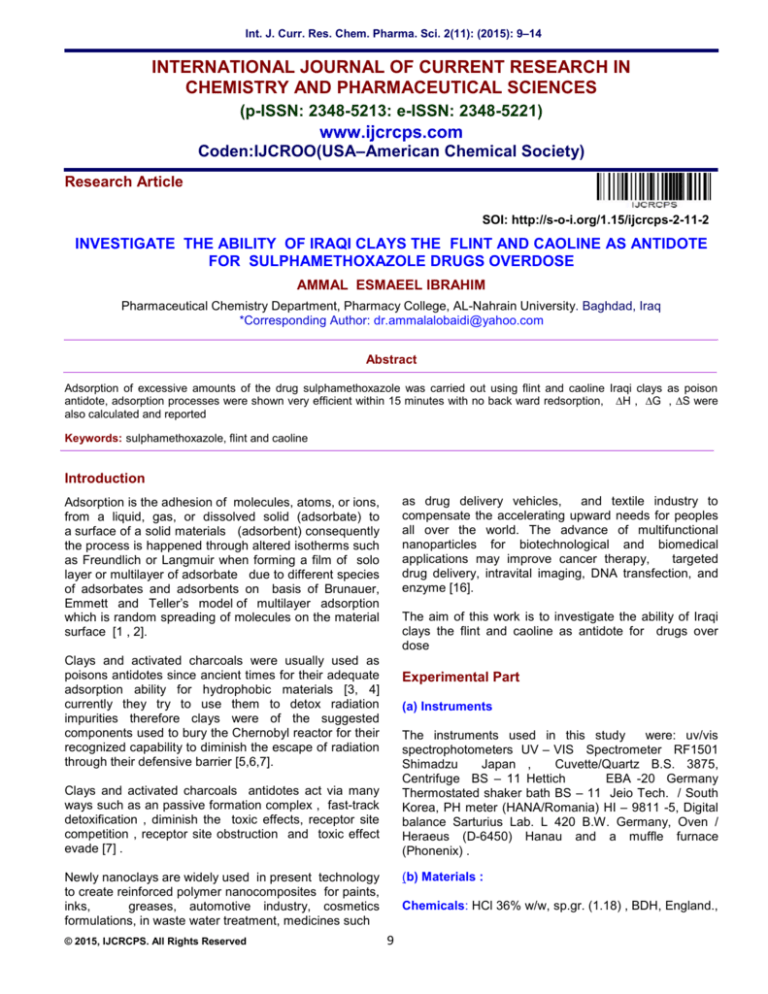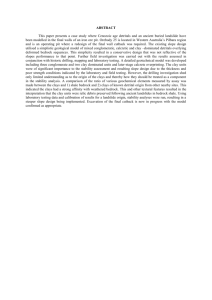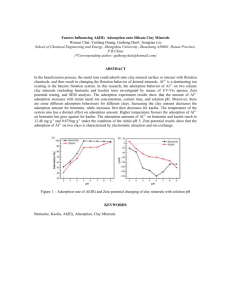
Int. J. Curr. Res. Chem. Pharma. Sci. 2(11): (2015): 9–14
INTERNATIONAL JOURNAL OF CURRENT RESEARCH IN
CHEMISTRY AND PHARMACEUTICAL SCIENCES
(p-ISSN: 2348-5213: e-ISSN: 2348-5221)
www.ijcrcps.com
Coden:IJCROO(USA–American Chemical Society)
Research Article
SOI: http://s-o-i.org/1.15/ijcrcps-2-11-2
INVESTIGATE THE ABILITY OF IRAQI CLAYS THE FLINT AND CAOLINE AS ANTIDOTE
FOR SULPHAMETHOXAZOLE DRUGS OVERDOSE
AMMAL ESMAEEL IBRAHIM
Pharmaceutical Chemistry Department, Pharmacy College, AL-Nahrain University. Baghdad, Iraq
*Corresponding Author: dr.ammalalobaidi@yahoo.com
Abstract
Adsorption of excessive amounts of the drug sulphamethoxazole was carried out using flint and caoline Iraqi clays as poison
antidote, adsorption processes were shown very efficient within 15 minutes with no back ward redsorption, ∆H , ∆G , ∆S were
also calculated and reported
Keywords: sulphamethoxazole, flint and caoline
Introduction
as drug delivery vehicles,
and textile industry to
compensate the accelerating upward needs for peoples
all over the world. The advance of multifunctional
nanoparticles for biotechnological and biomedical
applications may improve cancer therapy,
targeted
drug delivery, intravital imaging, DNA transfection, and
enzyme [16].
Adsorption is the adhesion of molecules, atoms, or ions,
from a liquid, gas, or dissolved solid (adsorbate) to
a surface of a solid materials (adsorbent) consequently
the process is happened through altered isotherms such
as Freundlich or Langmuir when forming a film of solo
layer or multilayer of adsorbate due to different species
of adsorbates and adsorbents on basis of Brunauer,
Emmett and Teller's model of multilayer adsorption
which is random spreading of molecules on the material
surface [1 , 2].
The aim of this work is to investigate the ability of Iraqi
clays the flint and caoline as antidote for drugs over
dose
Clays and activated charcoals were usually used as
poisons antidotes since ancient times for their adequate
adsorption ability for hydrophobic materials [3, 4]
currently they try to use them to detox radiation
impurities therefore clays were of the suggested
components used to bury the Chernobyl reactor for their
recognized capability to diminish the escape of radiation
through their defensive barrier [5,6,7].
Experimental Part
(a) Instruments
The instruments used in this study
were: uv/vis
spectrophotometers UV – VIS Spectrometer RF1501
Shimadzu
Japan ,
Cuvette/Quartz B.S. 3875,
Centrifuge BS – 11 Hettich
EBA -20 Germany
Thermostated shaker bath BS – 11 Jeio Tech. / South
Korea, PH meter (HANA/Romania) HI – 9811 -5, Digital
balance Sarturius Lab. L 420 B.W. Germany, Oven /
Heraeus (D-6450) Hanau and a muffle furnace
(Phonenix) .
Clays and activated charcoals antidotes act via many
ways such as an passive formation complex , fast-track
detoxification , diminish the toxic effects, receptor site
competition , receptor site obstruction and toxic effect
evade [7] .
(b) Materials :
Newly nanoclays are widely used in present technology
to create reinforced polymer nanocomposites for paints,
inks,
greases, automotive industry, cosmetics
formulations, in waste water treatment, medicines such
© 2015, IJCRCPS. All Rights Reserved
Chemicals: HCl 36% w/w, sp.gr. (1.18) , BDH, England.,
9
Int. J. Curr. Res. Chem. Pharma. Sci. 2(11): (2015): 9–14
were obtained from, Sulphamethoxazole was obtained
Medical Appliances (SDI), Samarra, Iraq. Flint and
Kaoline clays: were obtained from the (General
Company for Geological Survey and mining),
Baghdad, Iraq.
from the State Enterprise for Drug Industries and
°
37.5 C, then to determine the kinetic
physical
constants such as Gibbs free energy (∆G), enthalpy
(∆ H) and entropy (∆ S).
Samples for spectrophotometric analysis were
centrifuged for 22 minutes at 5000 rpm, filtered by filter
paper no. 42 then centrifuged again to get rid of any
suspended particles in order to obtain accurate
absorbency readings.
(c) Methodology :
The clays were washed with excessive amounts of
demineralized water many times to remove the
soluble impurities, dried at 115°C for three hours
(constants weight) , crushed with crusher machine,
sieved by molecular sieves to the grades of 75,
80,150,200 and 250 µm then stored dry in sealed
plastic containers.
°
Samples of the clays were ignited at 1100C with the
aid of a muffle furnace for 3 hours to determine the
weight loss of each clay .
Adsorption experiments were carried out by shaking
each clay (0.1 gm of 75 µm particle size) with 10 ml of
sulphamthoxazole solution with
concentrations
-5
-4
-3
-3
5x10 , 5x10 , 5x10 and 10 M/L respectively in
a thermostatic shaking water bath at 150 rpm.
Results and Discussion
Flint and Kaoline clays proved to be very efficient as
antidote for overdose of sulphamethoxazole drug
°
within 15 minutes contact time at 37.5 C and showing
no re desorption (reverse reaction) during all the
reaction time which last 120 minutes (Fig 1& 2).
Series of experiments were carried out to determine
the best residence time for adsorption process at
S = 0.01265737
r = 0.99965132
1 .3 9
c ( mg /10 ml )
1 .1 6
0 .9 3
0 .7 0
0 .4 6
0 .2 3
0 .0 0
0.0
22.0
44.0
66.0
88.0
11 0.0
132.0
time , min.
c ( mg / 10 ml )
Fig.-1 Adsorption capacity for flint along contact time .
1 .3
9
1 .1
6
0 .9
3
0 .7
0
0 .4
6
0 .2
3
0 .0
0
0.0
22.0
44.0
66.0
88.0
11 0.0
time , min.
Fig - 2 Adsorption capacity for caoline along contact time.
© 2015, IJCRCPS. All Rights Reserved
10
132.0
Int. J. Curr. Res. Chem. Pharma. Sci. 2(11): (2015): 9–14
Adsorption process for flint and aoline clays as seen
by Figures 3 & 4 was going along Freundlich and
Küster isotherm (1894) since the relationship of Qe
(mg of adsorbate / g of clay) against Ce ( mg / L) the
equilibrium concentration of the adsorption reaction
showing a straight line for both clays according to the
following empirical formula ( Eq. 3&4 ) which could be
applied for gaseous or solid adsorbates where C is the
concentration of the adsorbate , ( x / m ) the mass
ratio of adsorbate to adsorbent ( Qe ), k and n are
empirical constants :
=kC
1/n
Log Qe = log Kf+
…. Eq.- 1
log Ce
….. Eq. 2
Fig.-3 Adsorption isotherm for sulphamethoxazole by Flint clay .
Fig. - 4
Adsorption isotherm for sulphamethoxazole by caoline
The empirical constants as seen in table – 1 reveals
that adsorption of sulphamthoxazole depends greatly
upon the active sites of the clay surface as Si ---O or
Al----O as well as their hydrogen bonding formed
thereof by clays elemental compositions ( Table -2 )
because the values of ( 1/n ) is small therefore the
drug concentration does not affect the adsorption rate
extensively.
Table – 1 The empirical constants for flint and caoline for sulphamthoxazole adsorption.
Clay type
Flint
1/n
0.20825
Kf
10.85
n
4.789
r
0.972
caolin
0.2112
10.69
4.735
0.953
© 2015, IJCRCPS. All Rights Reserved
11
Int. J. Curr. Res. Chem. Pharma. Sci. 2(11): (2015): 9–14
Table-2 Elemental compositions of flint and caoline clays
Clay
Flint **
caoline**
Al2O3 %
34
35.05
SiO2 %
46
48.57
Fe2O3 %
1
1.34
MgO
TiO2 %
K 2O %
CaO %
0.77
1.19
0.08
0.6
* * The General Company for Geological Survey and mining, Baghdad, Iraq.
According to Vant Hoff – Arrenheus equation :
=
+ ……….
Gibbs free energy change is also calculated using the
following equation at 310.5 K :
Eq. 3
G =∆ H - T ∆ S
……….. Eq. 5∆
The values of the physical constants are shown in
table–3 conclude that the adsorption process occurred
spontaneously for the negative values of ∆G,
meanwhile ∆H attapulgite is negative for Flint and
caoline, the overall free energy proceed the adsorption
reaction readily spontaneously
Enthalpy ( ∆H ) and entropy ( ∆S ) changes could
be calculated using (Fig 5 & 6) where:
Xm is the maximum amount of adsorbate .
Xm = maximum amount of adsorbate ( mg ) by one
gram of adsorbent.
Fig .- 5 Adsorption capacity of sulphamethoxazole by Flint at different temperature degrees .
Fig .- 6
Adsorption capacity for sulphamethoxazole by caoline at different temperature degrees .
© 2015, IJCRCPS. All Rights Reserved
12
Int. J. Curr. Res. Chem. Pharma. Sci. 2(11): (2015): 9–14
Table- 3 The values of the physical constants
Clay type
∆H , Kj/M
∆G ,Kj/M
∆S ,J
Flint
-0. 383
- 5.916
10.8
caoline
-0. 180
- 5.918
11.078
The clays were ignited by a muffle furnace at 1100
after ignition due to alteration of the active sites on the
C° for 3 hours therefore the properties of the clays
surface of the clays because the weight loss due
were changed as seen in (Table – 4) for the
to the destruction and decomposition of organic
adsorption capacity (Qe) of both clays became lower
and inorganic inclusions of the clays
Table – 4 Effect of clays ignition on their adsorption capacity .
Clay
Weight loss %
Qe ( mg / g )
Before igintion
Qe ( mg /g )
After hgnition
Flint
caoline
13.751
10
22.866
23
20.656
20.799
Conclusion
This study revealed that the loading capacity of each
clay ( Qe ) is up to 23 mg/g of adsorbent clay, which
is acceptable value but it is worth to increase this
ability up to hundreds folds by convert the clays to
nanoparticles
for surfaces area increase by
thousands times fold therefore the adsorbing active
sites of the clays which is responsible for attraction of
adsorbate
molecules and/ or ions are
greatly
increased .
9- Hasmukh A patel, RAjesh S Somani, Hari C Bajaj
and Raksh V Jasra , Bull. Mater. Sci., Vol. 29, No.
2, April 2006, pp. 133–145. © Indian Academy of
Sciences
10- Hasmukh A Patel, Rajesh S Somani, Hari C Bajaj
and Raksh V Jasra , Bull. Mater. Sci., Vol. 29, No.
2, April 2006, pp. 133–145. © Indian Academy of
Sciences.
11 - Faheem
Uddin , Metallurgical and Materials
Transactions A 2804—Volume 39A, December
2008 .
12- Hong Shao, Ning Cao, Jianguang Li, Dawei Wang
, WeixueXu, Journal of Chemical Science and
Technology July 2013, Vol. 2 Iss. 3, PP. 128-134 .
13 - MohitBatra, Swati Gotam, Poonam Dadarwal,
Rahul Nainwani and Manoj Sharma , MohitBatra et
al / Journal of Pharmaceutical Science and
Technology Vol. 3 (10), 2011,709-716.
14-NwankwereEmeka Thompson, Gimba Casimir
Emmanuel, NdukweIloegbulam George, Isuwa Kari
Adamu , International Journal of Scientific &
Technology Research Volume 4, Issue 02,
February 2015.
15-Zhaohui Tong, Water-based suspension of
Polymer Nanoclay Composite
Prepared via
Miniemulsion Polymerization , School of Chemical
and Biomolecular Engineering, Georgia Institute of
Technology December 2007.
16- Chilvers E., Hunter, J. and Nicholas A. “Davidson’s
Princples and practice of Medicine” ,18th edition
,U.K.(1999), pp: 1110-1120.s.
References
1-Adsorption is present in many natural, physical,
biological, and chemical systems, and is widely
used in industrial applications. "Glossary".The
Brownfields and Land Revitalization Technology
Support Center. Retrieved 2009-12-21.
2-Jump
up^ "absorption
(chemistry)". Memidex
(WordNet) Dictionary/Thesaurus.Retrieved 201011-02.
3-Thompson CJ.Poison and Poisoners. 1931. Harold
Shaylor, London.
4-Howland MA, Weisman R, Sauter D, Goldfrank
LR.Non availability of poison antidotes. N Engl J
Med 1986;314: 927-8
5-How to Detox Radiation Poisoning, © 2009
EMarketing Consulting LLC. All Rights Reserved.
6-WorldApplied Sciences Journal 16 (2): 275-279,
2012 ISSN1818-4952.
7-VV Pillay , JAPI • VOL. 56 • November 2008 .
8- S.S. Bhattacharya1 and Aadhar Mandot1, Int. J.
Pure Appl. Sci. Technol., 17(2) (2013), pp. 36-44
© 2015, IJCRCPS. All Rights Reserved
13
Int. J. Curr. Res. Chem. Pharma. Sci. 2(11): (2015): 9–14
17- Sorby D.L. and Plien E.M. [Adsorption of
phenothiazine derivatives by solid adsorbents], J.
Pharm. Sci., (1966), 55, pp:785-794.
18 - The adsorption of acebutolol, metoprolol, nadolo,
oxprenolol and timolol by attapulgite, charcoal,
kaolin and magnesium trisilicate], Pharm.
Acta.Helv. (1988), 63 (1), pp: 13-18 .
19- Al-Gohary O.M.N., In vitro adsorption of
mebeverine HCl onto kaolin and its relationship to
pharmacological effects of the drug in vivo ],
Pharm. Acta Helve. (1997), 72, pp:11-21
20- Mboya S.A. and Bhargava H.N., [Adsorption and
desorption of loperamide HCl by activated
attapulgite], Am. J. Helth. Sys. Pharm. (1995), 53
(24), pp: 2816-2818
21-Saadoon A. Isa, Sameer M. Jassim AND Hussein
K.A. Hussein, Iraqi J. Parma. Sci., Vol.14, 2005 .
© 2015, IJCRCPS. All Rights Reserved
14










